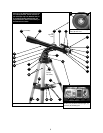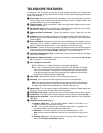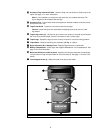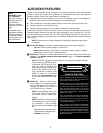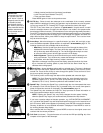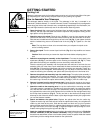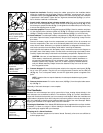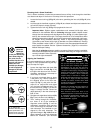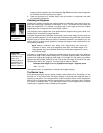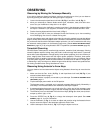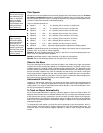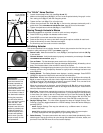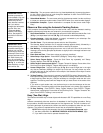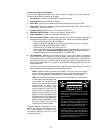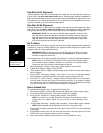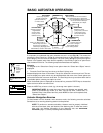
14
image) has been aligned to the main telescope. Fig. 13B shows these same images after
the viewfinder and main telescope are aligned.
5. Check this alignment on a celestial object, such as the Moon or a bright star, and make
any necessary refinements.
Choosing an Eyepiece
A telescope’s eyepiece magnifies the image formed by the telescope’s main optics. Each eye-
piece has a focal length, expressed in millimeters, or “mm.” The smaller the focal length, the
higher the magnification. For example, an eyepiece with a focal length of 9mm has a higher
magnification than an eyepiece with a focal length of 25mm.
Your telescope comes supplied with a low-powered 25mm eyepiece which gives a wide, com-
fortable field of view with high image resolution.
Low power eyepieces offer a wide field of view, bright, high-contrast images, and eye relief dur-
ing long observing sessions. To find an object with a telescope, always start with a lower power
eyepiece such as a 25mm. When the object is located and centered in the eyepiece, you may
wish to switch to a higher power eyepiece to enlarge the image as much as practical for pre-
vailing seeing conditions.
NOTE: Viewing conditions vary widely from night-to-night and site-to-site.
Turbulence in the air, even on an apparently clear night, can distort images. If an
image appears fuzzy and ill-defined, back off to a lower power eyepiece for a more
well-resolved image.
The power, or magnification of a telescope is determined by the focal length of the telescope
and the focal length of the eyepiece being used. To calculate eyepiece power, divide the tele-
scope's focal length by the eyepiece's focal length. For example, you may wish to use a 25mm
eyepiece with the DS-2000 model DS-2114S. Look up the focal length of the DS-2114S under
"Specifications: DS-2114S," page 33. The focal length is listed as 1000mm.
Telescope focal length divided by Eyepiece focal length = Eyepiece power
1000 Ö 25 = 40
The eyepiece power, or magnification is therefore 40X (approximately).
The Barlow Lens
Some Meade telescopes include a power multiplier called a Barlow lens. Consisting of a lens
mounted in a 4"-long (10cm) tube, the Barlow doubles or triples the power obtained when an
eyepiece is used alone. In the example above, a 25mm eyepiece results in 40X magnification
with the DS-2114S telescope; when this same eyepiece is used in conjunction with a 2x Barlow
lens, power is doubled to 80X. To use the Barlow, insert it into the diagonal prism (refractor
models only) or eyepiece holder, followed by the eyepiece.
Fig. 15: 25mm and
9mm eyepieces.
DEFINITION:
A capital "X" is used
to denote an eye-
piece's (or a
Barlow's) power or
magnification. For
example, "40X" is
read as "40-power."



